I’ve always had a fascination with rural Americana. Nothing puts me at peace quite like a road trip to see out-of-the-way oddities, ghost towns, and tourist traps, and no region does it better than the Midwest. South Dakota has Wall Drug and the Mitchell Corn Palace, Nebraska has Carhenge and the Kearney Archway, Iowa has the Field of Dreams and the World’s Largest Truckstop, Wisconsin has the House on the Rock. And Minnesota? We have Paul Bunyan.
Paul Bunyan casts a giant shadow across the American imagination, and it’s doubly long in Minnesota. If you grew up here, you probably have a story to tell about Paul—learning Bunyan stories in school, summers visiting Paul Bunyan Land outside Brainerd, a particular statue you’d see on the way to a cabin.
Everyone knows a little something: tall, flannel shirt, big axe, pet ox. His name recognition in the state must be somewhere north of Naz Reid and Bob Dylan. But how much do you really know about Paul Bunyan? Where did this story come from? Is he based on a real person? Why is he associated with Minnesota? Like a stoned patron at a Monet exhibit, the closer I scrutinized the subject matter, the less of a clear idea I had of what I was looking at.
And so, following up my previous Racket investigations into Winnipeg and St. Paul, I set out to answer: What’s the deal with Paul Bunyan? This time the journey would take me not only across the state, but through a historical record of a folklore hero barely a hundred years old, but whose story and image has been forged and remade a dozen times over as he bounds between an oral tradition, unscrupulous marketing, popular culture, and back again.
Early History: Paul Bunyan of the Logging Camps
The lumber industry across the Upper Midwest exploded in the second half of the 19th century, a confluence of increased demand from growing midwestern cities, exhaustion of the eastern forests, and the ongoing process of dispossession of lands from the Native inhabitants opening up new forests for exploitation. By 1890, tens of thousands of laborers, many of whom were recent immigrants, ventured into the old-growth forests of Michigan, Wisconsin, and Minnesota every winter for months spent felling, stripping, and transporting trees until the melting snows of spring created river conditions capable of moving logs downstream to sawmills for processing.
The working day was long, strenuous, and dangerous—and all in the freezing cold of a pre-climate change Minnesota winter. Camps ranging from a dozen to a couple hundred men were effectively cut off from society for months at a time with little to entertain themselves in their few free hours except each other, with song, cards, and most importantly of all, storytelling. It’s from these stories told among lumberjacks in the Midwest forests that Paul Bunyan was first born in the 1880s.
The origin of Paul Bunyan’s name is a mystery. Some early scholars believed that a great Quebecois lumberjack with that name actually existed and inspired the figure. Later scholars found little evidence to back up those claims, and believed the name of Bunyan to be just as fictional as the rest of his exploits. Whether his name was inherited from a real person or manufactured in the moment isn’t particularly important. While many figures of American folklore have a real person as a point of departure (e.g., Johnny Appleseed, Davy Crockett), in every meaningful way, Paul Bunyan is completely made up.
Paul Bunyan’s persona wasn’t settled in these early tall tales. Sometimes he’s depicted as a hard-driving camp boss around whom incredible things happen. His name was used less to evoke an image of a specific character, but more as a wink to the others that starting a story with “the winter I worked in Paul Bunyan’s camp” was going to be followed by fanciful embellishment.
“It was the winter of the ‘blue snow’ when Paul was first heard of. In that winter, the tale goes, there was a 40-foot fall of blue snow in Northern Minnesota. That winter they had to cut the trees from forty feet above the ground, and in the spring there was a forest of stumps 40 feet high.”
In others, you can see the roots of his later depictions as a flannel-clad demigod. Some describe his larger-than-life physique and abilities.
Bunyan was a powerful giant, seven feet tall and with a stride of seven feet… So great was his lung capacity that he called his men to dinner by blowing through a hollow tree a blast so strong that it blew down the timber on a track of sixty acres, and when he spoke, the limbs sometimes fell from trees.
Other tales detail his impact on the American landscape, forming lakes and rivers with his deeds, or in this case, making North Dakota treeless:
Paul logged off North Dakota one winter, and anyone who does not believe he was a good logger may look at North Dakota.
Many are nearly inscrutable to a modern audience lacking a lumberjack’s trade knowledge and sense of humor.
He was accused of using a split pencil when charging the loggers for socks, tobacco and mackinaws. In this manner he charged each man double and made money for the camp.”
And some stories have been lost to time when the content was too risque to be repeated to a graduate student collecting folklore, or to publish in the early books that collected these stories. Lumberjacks invented these tales, after all, and one can only imagine what they might say of a man so anatomically gifted. While hints exist to an oral tradition that includes Paul’s exploits in taverns and brothels, they didn’t make it into the written record.
While later tales would put his birthplace anywhere from Maine to California, Bunyan’s origins in folklore are certainly in the Upper Midwest. While Minnesota, Wisconsin, and Michigan all have early recorded instances of Paul Bunyan lore, scholar Michael Edmonds, whose excellent book Out of the Northwoods: The Many Lives of Paul Bunyan has informed much of this account, places the earliest reliable tellings as being near Tomahawk, Wisconsin, in 1885. Famous Rhilenader, Wisconsin, prankster Eugene Shepard, whose 1896 “hodag” hoax created national headlines and a legendary cryptid, is one of the earliest known tellers of Paul Bunyan stories, and claimed to have himself invented Paul Bunyan.
While Wisconsin may be the most likely site of Paul’s origins, Minnesota would soon take center stage in his continuing story.
Paul Becomes Famous
Paul Bunyan’s exploits likely never would have made it out of the lumber camps if not for William Laughead, a 30-something struggling graphic designer in the Twin Cities (sounding very much like the frontier version of the average Racket subscriber). In 1914, seeking a new customer base, the Red River Lumber Company was moving the base of its lumber operation from Minnesota’s rapidly depleting forests to California. Laughead, who had himself worked in lumber camps, pitched the idea to use the tall tales of Paul Bunyan to market Red River Lumber across the nation.
Laughead embellished and sanitized the tales he had heard in the camps, adapting them to his purposes as a marketer of a lumber brand. He made his own additions to the Bunyan canon, including the name of the big blue ox, due to his inarguable reasoning, “about as cute of a name as you could get for a great big ox would be Babe.”
The campaign wasn’t an immediate success. Most people, even in the lumber industry, had never heard of Paul Bunyan. But persistence paid off when a 1922 marketing pamphlet entitled “The Marvelous Exploits of Paul Bunyan” was picked up by the Kansas City Star, spreading his tales beyond the audience of wholesalers who would receive a lumber company’s marketing promotions.
The materials Laughead produced had been intentionally left uncopyrighted, under the assumption that boosting Paul Bunyan’s fame would only be a boon for the lumber company selling “Paul Bunyan’s pine.” These stories and characters could be cribbed, copied, retold and rewritten—and they were. By the mid-1920s, Bunyanmania had taken hold, with the character popping up in original novels, periodicals, and children’s books. In 1927, Hearst newspapers introduced Paul Bunyan to millions of readers across the country as “America’s Only Folk Lore Character” and two years later, “Paul Bunyan” was in the Encyclopedia Britannica.
From Logging to Lakes
Forests take hundreds of years to grow but only a few winters to cut down. Before European settlement, Minnesota had 31.5 million acres of forest covering half the state. By 1930, much of that was gone. Today, if you want to see what the forests of Minnesota looked like before the lumber industry, travel an hour northeast of Bemidji to the Lost 40 Scientific and Nature Area, which contains some of the only old-growth white pine forest left in the state. Here, 200-year-old trees grow upwards of 100 feet tall, and far too wide to put your arms around. The canopy and shaded forest floor they provide is more reminiscent of a trip to the redwoods than the cluttered woods of a contemporary Minnesota park. An 1882 surveying error resulted in these acres of forest never being opened for logging—the fact that we have any old-growth forest left at all is a bug, not a feature.
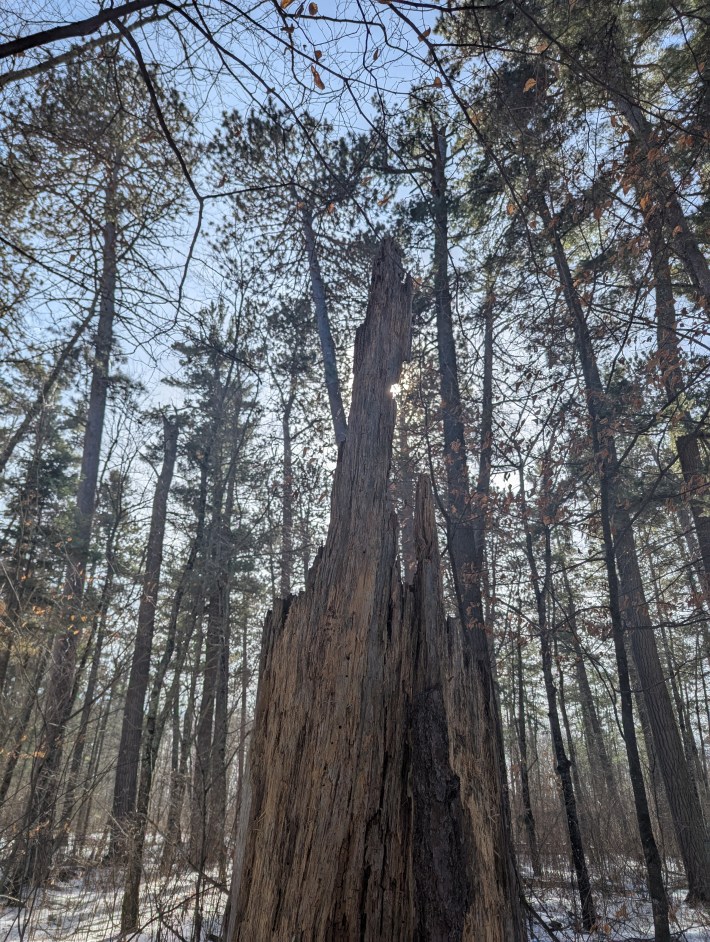
Thus, at the same time that Bunyanmania was sweeping the nation, the lumber regions of Minnesota, from Brainerd on north, were undergoing a huge economic and cultural shift as the logging industry left the state for good. To understand how Paul Bunyan became so intertwined with our state, I spoke to Johnathan Jaeger, a graduate student in Heritage Studies and Public History at the University of Minnesota. “You can see the region moving into tourism, moving into entertainment, and they're using Paul Bunyan to do that,” Jaeger says.
Seeking a bridge between the golden age of lumber and the burgeoning tourism industry, business owners and politicians adopted the branding and story of Paul Bunyan for the region. A folklore hero who was still largely obscure in 1925 had statues erected in both Brainerd and Bemidji by 1940. Today, Minnesota boasts over 124 Paul Bunyan-related locations by Jaeger’s count, including street names, businesses, hiking trails, and, of course, tourist attractions both famous and obscure. Jaeger has helpfully compiled a very exhaustive map of them all. That number dwarfs the nearest competitors (California and Michigan have 34 and 27, respectively), and roundly embarrasses Wisconsin’s meager 20 sites. Wisconsin may have given Bunyan life, but no state has put more effort into Bunyan’s legacy than Minnesota.
The Paul Bunyan Road Trip
Having only moved to Minnesota in 2013, I didn’t grow up with a connection to the Paul Bunyan story. My first association between Paul and Minnesota came from watching Fargo, where a roadside Bunyan statue accompanies a lonely “Welcome to Brainerd” sign in otherwise desolate fields of blowing snow. Ironically, the statue that first introduced me to Bunyan’s presence in Minnesota doesn’t exist in Brainerd—it was created for the movie—and the scene was shot in North Dakota. But the point stands—along with our peculiar (and painfully exaggerated) accents, Fargo casts Paul Bunyan as the avatar of Minnesotan identity.
While I may be late to the story, my fresh set of eyes could be perfect to provide an unbiased account of the state’s many Paul Bunyan attractions. I have no attachment to any particular statue or lakeside town’s set of claims. Who better to tell the story of Paul Bunyan in Minnesota than an objective outsider? Thus, I set out on a weekend in early March to visit as many Paul Bunyan sites as I could. Between Jaeger’s map, Roadside America, and furious googling, I had identified 16 different Bunyan features that could reasonably be hit in one weekend.
Mille Lacs and Crow Wing
I started my journey with a drive along the shores of Lake Mille Lacs to a cartoonishly painted wooden cutout of Paul and Babe outside of the Mille Lacs Lake Museum in the town of Isle. The museum, like many of the tourist-focused businesses of the area, was closed until May. A helpful sign in the window informed me “Closed for the season—Reason Freezen [sic].”
On the western shore of the lake, in the town of Garrison, you can find Paul Bunyan’s Walleye, a fish the size of a station wagon. There’s no evidence of Paul or Babe here, aside from a plaque detailing a three-day struggle by Bunyan to reel the fish in, ending with Paul wrapping his line around Babe’s horns so the ox could haul the walleye onto the beach where he still stands.
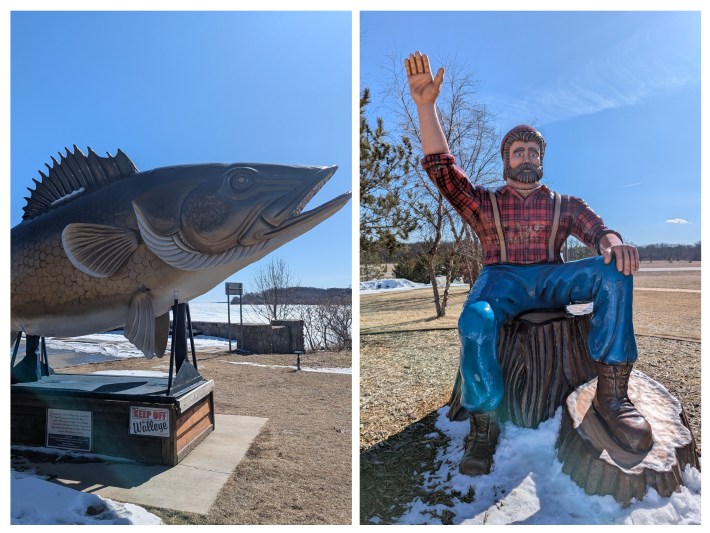
The Brainerd Lakes Welcome Center in Crow Wing has a nearly 12-foot-tall Paul Bunyan statue, arm extended in a motionless wave at visitors from his perch on a stump. The statue is dedicated to Merrill Cragun, a tourism promoter and resort owner who, in 1933, founded Paul Bunyan’s Playground Inc., which led the charge of resorts and towns adopting Paul Bunyan’s identity for tourism.
Inside the welcome center, manager Jess Vogt spoke to the success of Cragun’s campaign: “Paul Bunyan is our tourism. People come from everywhere to see Paul and Babe.” The gift shop surrounding her was a Paul Bunyan menagerie. No tchotchke is left unadorned by Paul or Babe or both. She explained that her mission this year is to add bigfoot to the Paul Bunyan pantheon, with new shirts depicting the silhouetted hominid walking alongside the towering lumberjack and his trusty ox.
Paul Bunyan Land
The Paul Bunyan Amusement Center was once the family-friendly gem in the crown of Paul Bunyan attractions. Opened in Brainerd in 1950, the park featured a 26-foot-tall animated, talking Paul Bunyan who reportedly delighted children by knowing them by name. (One wonders if children were more easily amused prior to iPads.) High costs and declining admission forced the park to relocate in 2003, merging with another attraction, This Old Farm Pioneer Village, six miles east of town, to become Paul Bunyan Land. The original site is now a Kohl’s, with the only evidence of decades of cheerful family fun being a massive set of footprints in the parking lot—a haunting memorial to the rapacious cycles of capitalism. (I'd give any amount of Kohl's Cash to have it back...)

The amusement park was predictably closed for the season, with a billboard-sized marquee belated wishing passing traffic “Seasons Greetings from Paul - Babe.” A truly massive Babe in the parking lot was accessible, while Paul himself seemed to be shut away for the winter. My glimpses through the fence gave the impression of a park with its best days behind it, though Yelp reviews note that the poor maintenance of the rides adds an exhilarating sense of real danger, and a 2019 visitor shared that her group had a very pleasant time while tripping on acid.
Brainerd
In Brainerd itself, you can’t miss Paul Bunyan. He looms on the sign for a strip-mall massage parlor. A welding school advertises its trade with sheet metal outlines of Paul and Babe. The distinctively crenellated, turret-shaped Brainerd water tower predates his popularity, but is colloquially known as “Paul Bunyan’s Flashlight” or “Paul Bunyan’s Golf Tee.”
I stopped in CatTale Books & Gifts, where my quest for Bunyan literature was rewarded with a rare 100-year-old copy of James Stevens’s Paul Bunyan. Stevens’s 1925 novel not only introduced Bunyan to many Americans, but was one of the most influential in crafting the popular image of Paul as a herculean giant capable of terraforming the American landscape. Local teen punks Kaiah and Grey helped me find the book, though not without some good-natured ribbing. “Doesn’t he have a blue dog?” Grey mused upon the mention of Bunyan’s name, not 200 yards from a statue of Babe. Kaiah recalled having visited a Paul Bunyan statue on a field trip while growing up in nearby Bemidji.
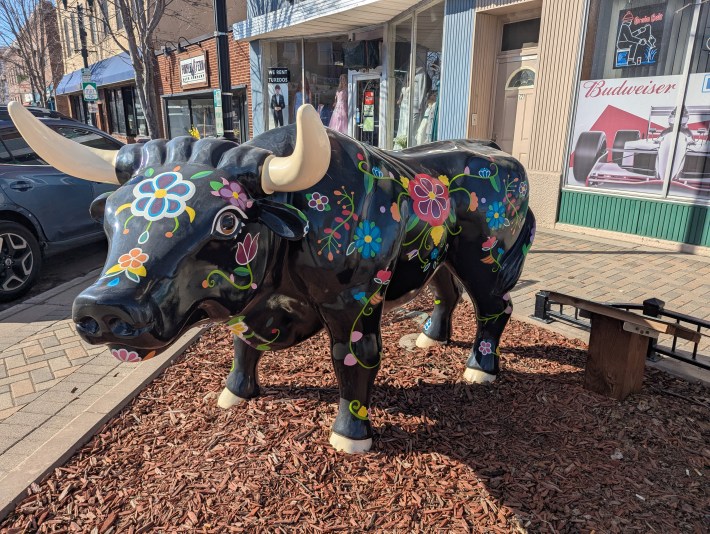
Since 2008, roughly 20 Babe statues have bespeckled the Brainerd Lakes landscape, sponsored by local businesses. Ironically smaller than a normal ox, these statues, though not their decoration, are the work of local sculptor Josh Porter of Avalon Studios. Porter originally worked out of the Twin Cities, where he was part of Peanuts on Parade in the early 2000s, which saw over a 100 sponsored Snoopys fan out across St. Paul. Upon relocating to the Brainerd Lakes area in the 2000s, Porter adapted the Peanuts promotion to the land of Paul Bunyan. Not all of the original statues remain, though many can be spotted around town still.
Porter’s work isn’t limited to Babe—he designed and constructed several statues of Paul himself, including the aforementioned welcome center in Cragun’s honor, and he refurbished the statues at Paul Bunyan Land. He builds the statues out of fiberglass, adding molding compound for fine details like the face. Knowing how much Paul Bunyan Land meant to a generation of Minnesotans, I asked him what it meant to work on the iconic talking statue. “I grew up in East Grand Forks and the only Paul Bunyan I knew growing up was the one in Bemidji,” he says. “I didn’t even know Brainerd had one.” His wife, originally from nearby Baxter, set him straight. Despite my attempts to offer him the mantle of a local celebrity for his Paul Bunyan statues, he declined. Most of his work these days is on selling and repairing lion-shaped drinking fountains.
Route 371
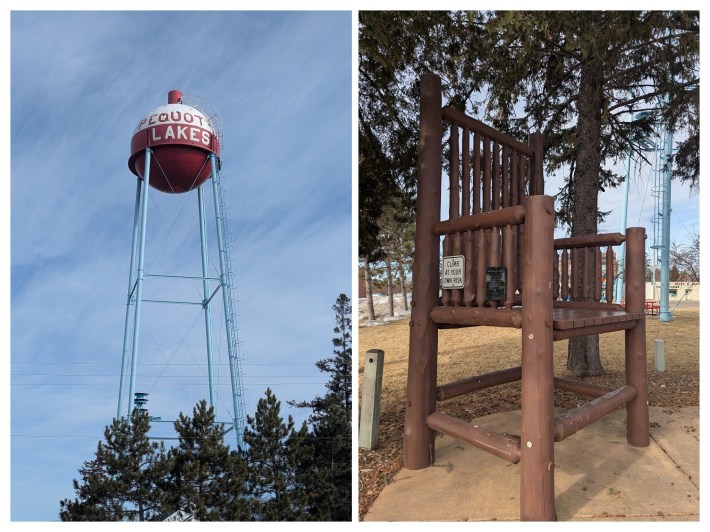
The road from Brainerd to Walker is the main artery of central Minnesota’s cabin country, and hardly 10 minutes goes by in the car without an opportunity to see Paul Bunyan, one of his kin, or an object he left behind. Not to be outdone by Brainerd’s water tower, Pequot Lakes built their own Bunyan-themed hydraulic infrastructure in 1987, with the iconic red and white “Paul Bunyan’s Fishing Bobber” looming hundreds of feet above the town. Go to the base of the tower, and you can find another painted Babe statue, along with Paul Bunyan’s chair—an improbably large, rough-hewn dining chair standing about a dozen feet tall, with a thoughtful sign warning visitors to “climb at your own risk.” (The Pequot Lakes Paul Bunyan chair is not to be mistaken with Paul’s adirondack chair in Grand Rapids, which can easily seat a family of four.)
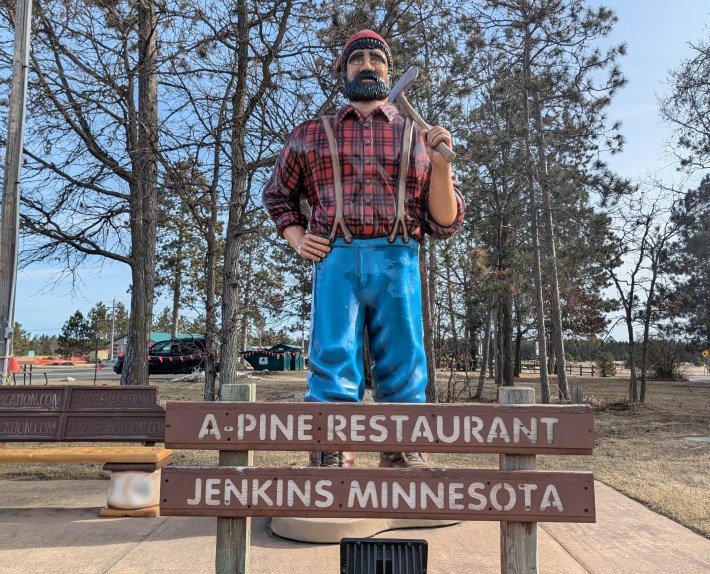
Just up the road in Jenkins, the A-Pine Family Restaurant sports another Josh Porter Paul Bunyan, commissioned in 2008 and standing sentry over the family dining establishment alongside a bench made of s'mores ingredients. Their website provides a nice work of fan fiction regarding Paul’s visit to their restaurant and personal satisfaction with their portion sizes.
Another 10 minutes north, the Pine River Information Center was once home to Paul Bunyan’s boots, until a rare 2010 North Woods tornado unceremoniously removed them. Now, two large concrete pads remain where the boots once stood, instead showcasing Paul Bunyan’s footprints—when god closes a door, she opens a window. The visitor center inside supposedly houses Paul Bunyan’s baby shoes, but was closed during my visit.
Akeley and Hackensack
If you know anything about Akeley and its 400 residents, it’s probably because of Paul Bunyan. Since 1949, Akeley has hosted Paul Bunyan Days, an annual festival which celebrated its 75th year in 2024. The town staked its claim as Bunyan’s hometown and supported their claim with the construction of a wooden cradle the size of an ox cart. For decades, the cradle was the sole Bunyan feature in town, until 1984, when they added the world’s largest Paul Bunyan. Technically, there are taller statues in California and Oregon, but both depict Paul standing at full height. Akeley’s Paul is knelt down, offering his hand as a seat or photo opportunity for visitors, and thus Akeley’s Paul is the largest in scale. A nearby Paul Bunyan Historical Museum is reported to focus on local history and not fictional lumberjacks, but was closed upon my visit.
Not to be outdone by Akeley, nearby Hackensack debuted its own character and festival in 1952. Seeking an original twist on Bunyan iconography, the town created a 17-foot love interest for Paul to debut at a new festival: Sweetheart Days. A national competition gave her a name, Lucette Diana Kensack, and thus a character who makes no appearance in the Paul Bunyan canon draws tourists to town to see what sort of woman it takes to catch the eye of a giant lumberjack.
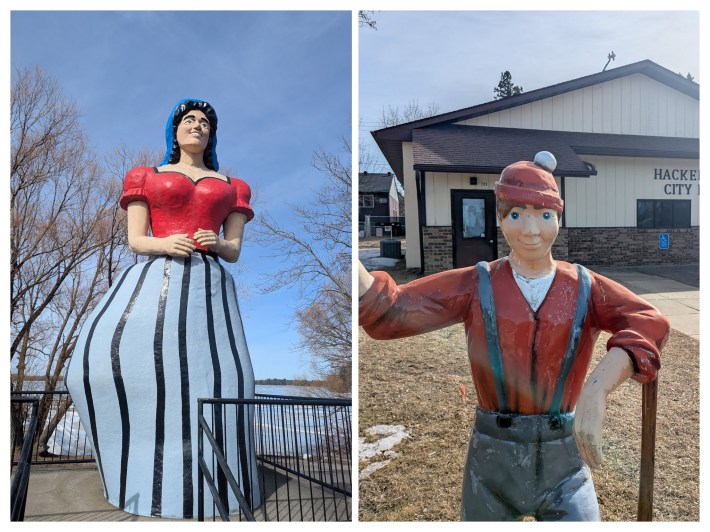
Lucette was a hit for Hackensack, and Sweetheart Days continues 70 years later, but success breeds hubris. Following repairs in the early 1990s, the town tried to introduce a second character: Paul Jr., son of Paul and Lucette. This was controversial for two reasons:
- Paul and Lucette were officially only sweethearts, not married, and thus the out-of-wedlock child was scandalous to certain locals
- The statue sucks, in a Scrappy Doo sort of way, with a 2002 USA Today article reporting locals referring to Paul Jr. with such vicious terms as “‘Lawn Jockey.’ ‘Dweeb.’ ‘Birth defect.’”
The first issue was solved through a marriage license being “found” in the Chamber of Commerce’s basement and a wedding ring being drawn on for Lucette. There’s no fixing ugly though, and Paul Jr. was eventually relocated to city hall in a less public spot.
Cordwood Pete
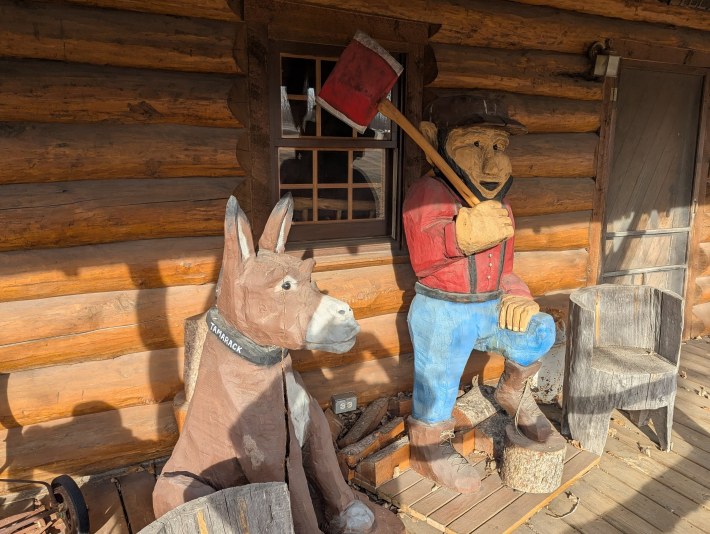
Not every attempt to invent a character puts a town on the map. Fosston, located 45 miles west of Bemidji, is not a town I was familiar with. In an attempt to change that, in 2001 the mayor claimed to have found a time capsule revealing the legend of Cordwood Pete—the 4-foot-9 younger brother of Paul Bunyan. Owing his small stature to his brother’s legendary appetite leaving little food behind, Pete has his own lumberjacking feats featured on the town website and his own animal companion: a donkey named Tamarack. The two wood-carved statues reside on the edge of town in the East Polk Heritage Center, otherwise surrounded by historic buildings and a veterans memorial complete with an attack helicopter.
There’s not much online to suggest that the legend of Cordwood Pete and Tamarack has gone far beyond Fosston, nor is it clear that Fosston benefited much from his introduction. That said, a national newspaper never printed an article of slurs used against him, so he may beat out Paul Jr. in a popularity contest.
Bemidji
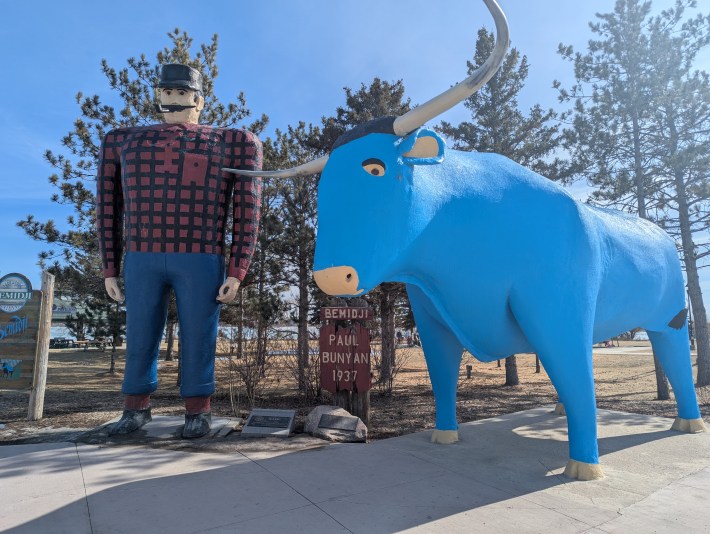
Paul Bunyan Park, on the shore of the eponymous lake in downtown Bemidji, houses the oldest Paul Bunyan display in the world. Though Brainerd had the first, the Paul and Babe statues in Bemidji have posed for visitors in the same spot since 1937. Originally made out of cloth and chicken wire for a winter carnival, the two appeared in Life magazine the same year they were introduced. Babe was originally mounted on a truck that could drive around the state to promote Bemidji’s tourism, but became stationary only two years later.
For being 88 years old, the statues are well maintained and brightly painted. They were refurbished in 2022 after Paul briefly lost an arm in 2021. Their age shows most notably in their not particularly life-like shape; Paul’s figure makes the phrase barrel-chested feel uncomfortably literal, and Babe’s longing look and locked knees make his presence seem not of his own volition.
On the unseasonably warm day I visited, the big attraction of the park was the nearby playground, but if the nearby tourist shops are to be believed, Paul and Babe can still draw travelers in need of a picture, not to mention a Paul Bunyan koozie, T-shirt, or shot glass. Even non-tourist businesses get in on the action, with Paul Bunyan Sub Shop offering sandwiches, Paul Bunyan Playhouse live theater, and Paul Bunyan Broadcast Company another non-stop rock block.
Paul’s Grave

While many towns have fought for the title of Paul Bunyan’s birthplace, only one claims to be his final resting place. You’ll have to go north—past Bemidji, past the Lost 40, all the way to Kelliher. There, in Paul Bunyan Memorial Park, on a suspiciously giant-sized mound of grassy earth, obscured by snow during my visit, stands a grave marker for Paul Bunyan and the simple epitaph: “Here lies Paul, and that’s all.” If Minnesota is to claim his birth, his life, his sweetie, his brother, his son, his chairs, his flashlight, and his fishing tackle, why not his resting place as well?
Just as Paul met his end in Kelliher, so concluded my tour of Paul Bunyan sites in Minnesota. Several sites went unseen on my trip. Some were on private resorts like a statue at Cragun’s Resort or Paul Bunyan’s axe and stump cabin at Northland Resort on Leech Lake, others, far afield, like Paul Bunyan’s marble in Chisolm, Paul Bunyan’s anchor in Ortonville, and Paul Bunyan’s bed—a geological formation in Niagara Cave in southeastern Minnesota. Still others have been lost to time, like the bowling Paul Bunyan and Babe from Baxter, who were carted and shipped to North Carolina after their bowling alley closed in 2011.
But the sites and statues that make up Roadside America entries and tourism pamphlets aren’t the full story of Paul Bunyan. Part of his story is about what is left out of his story altogether.
Settler Nostalgia
North America was a great big land with a great big job to be done
A job that needed a great big man—Paul Bunyan was the one.
In 1958, Disney released a Paul Bunyan short that opened with these words, jauntily set to song. Over the course of the 17-minute cartoon, Paul, voiced by Thurl Ravenscroft of Tony the Tiger and The Grinch fame, terraforms his way across the American landscape, manifest destiny made incarnate. His footprints fill up with water to make the 10,000 lakes of Minnesota, he carves the Missouri River, builds Pike’s Peak, carves Yellowstone and the Grand Tetons in his adventures with Babe. The felling of the great forests of America is depicted not as an ecological tragedy, but a heroic deed opening previously useless old-growth forest to agriculture and civilization. I suspect it’s this depiction of Paul Bunyan—forming the very geography of the country through his deeds—that sticks in the mind of most folks who have grown up in the decades since the cartoon.
While no one believes Paul Bunyan’s exploits in any literal way, myth still has power. And notable to the Paul Bunyan myth presented in the Disney cartoon is who Paul Bunyan and Babe don’t encounter in their travels: any Indigenous people on the lands they transform. Paul Bunyan stories, particularly as they move from the oral tradition of lumberjacks to broader American fables, imagine an empty and pristine country, ripe for transformation to the needs and desires of European settlers. The actual history of the lumber industry in America is one of Native dispossession, and even Native people as lumberjacks.
University of Wisconsin professor Kasey Keeler describes this as settler nostalgia, a process by which settlers to an area create an imagined past of the region to which they can connect. If Paul Bunyan, a white settler himself, created the rivers and lakes that white settlers now vacation in, then it follows that the land was made for them. How could Ojibwe or Dakota people have lived for hundreds or thousands of years in a landscape that was custom built by a giant lumberjack and a blue ox?
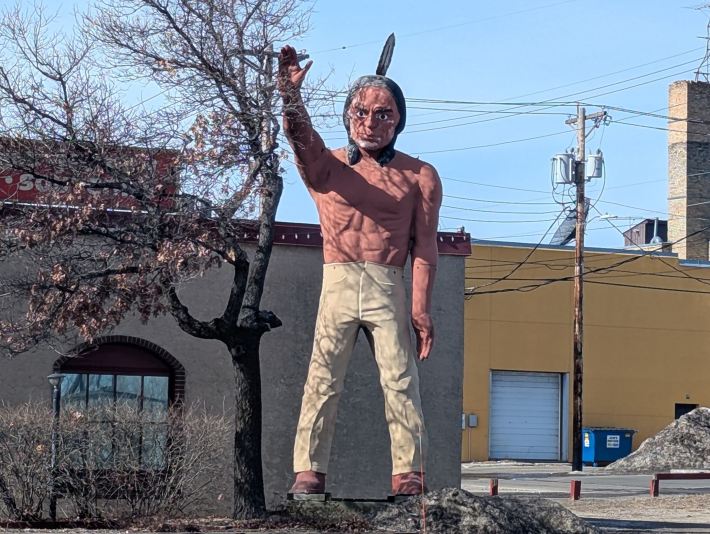
There’s another statue in Bemidji, across the street from Paul Bunyan Park, at Morell’s Chippewa Trading Post. Though tall, this one is not of Paul or Babe, but of a Native man, face in a stern glare, arm outstretched, gesturing, perhaps, at the similarly scaled man and ox just across the street. Though not originally intended as such, over the years this statue has become known as Nanabozho, a heroic figure of Ojibwe mythology.
As Paul Bunyan populated the landscape of American folklore, so too did he cross over into the folklore of the Native people resisting colonialism in the area. As the story goes, Nanabozho fought Paul Bunyan to stop him from cutting down the last trees in the area, thus preserving the wilderness of the Boundary Waters. He slapped Paul Bunyan with a walleye hard enough to knock him on his ass, the imprint forming lake Bemidji, and pulled at his whiskers, explaining why the Bemidji Paul has no beard and faces west, banished from the land.
Even the Disney cartoon imagines a similar fate for Paul. Having conquered the country and finding themselves obsolete to a mechanized lumber industry, Paul and Babe retreat to Alaska, not yet a state in 1958, where their antics can still be seen in the aurora borealis. Both the stories celebrating Paul Bunyan and those resisting him agree: His work in the country has long since finished, whether he has been banished by Nanobozho, sought out new frontiers in Alaska, or laid to rest in Kelliher.
So… What’s the Deal With Paul Bunyan?
Paul Bunyan started in the campfire stories of North Woods lumberjacks, spinning yarns about their work in the camps of winters past. For the Red River Lumber Company, he became a corporate mascot, connecting their product to the lumberjack tradition, even as their industry shifted across the American countryside. To the novelists and reporters of the 1920s, his stories were a gateway to distant and isolated lumber camps and a vision of a masculine American folklore. To the Chambers of Commerce around Brainerd and Bemidji, he was a bridge from a lumber economy to a tourism economy. To the Native people of Minnesota, he was a symbol of colonization to be resisted. To many settlers in Minnesota, he was a symbol of colonization to be celebrated.
Johnathan Jaeger describes Paul Bunyan to me as a figure of nostalgia. “Inherent to nostalgia is looking back on something that you think existed and didn't necessarily exist… there was not a time when the land was empty, even though that's what the Paul Bunyan story perpetuates,” the U of M grad student explains. While I’m quick to distance myself from the sort of settler nostalgia that Keeler describes and the Bunyan myth celebrates, I admit to being nostalgic for other aspects of Bunyan.
At a time in America when each city is so much like another, when all politics are national and nothing is local, when tourist towns from Miami to Seattle sell the same junk with different city names, sandwiched between Chipotles and Starbucks, Paul Bunyan feels unique to our region. Even if nearly every U.S. state has some reference to Paul or Babe, no other state takes it quite as seriously as Minnesota. When you put a statue of Paul Bunyan in a movie, the viewer understands you’re in Minnesota.
Paul Bunyan makes me nostalgic for a time when you could hop in a car for a day and be genuinely surprised by the unique eccentricities of the place where you ended up, when deeply mediocre roadside attractions were still on their first coat of paint and towns competed to build really large chairs and fishing implements that might put them on the tourism map. These sites and stories have a charm and oddity that feel refreshing in a world of mass culture. Paul Bunyan is a reminder that you don’t need a hundred years of tradition or religious conviction to have an annual festival, just make up a guy and throw a party for him.
In the month between my trip and the publication of this story, Nanobozho moved. His erstwhile home, Morell’s Chippewa Trading Post, relocated, seeking cheaper rents out by the highway. After over a half-century facing down Paul Bunyan in Bemidji, Nanobozho was disassembled, loaded on a flatbed truck, and shipped to a new home in Illinois, at the American Giants Museum. There, he’ll be but one example of the phenomenon of “muffler man,” roadside statues named after their propensity to hold a giant muffler to advertise automotive repair shops. The muffler men were made from the same cast, but could be decorated to suit different purposes and themes. Nanobozho was one of 25 remaining Native American styled statues around the country, but that’s only half as many as the original and most popular figure to be depicted by a muffler man: Paul Bunyan.
If tales of Paul and Babe carving up the landscape of a virgin frontier is no longer a useful parable, then perhaps it’s a 20-foot-tall fiberglass Indian installed to sell souvenirs accidentally becoming a symbol of resistance, only to wind up on a flatbed truck barrelling down I-94 to some new frontier in roadside attractions. Paul Bunyan’s history is a tale of exaggerated bullshit, the blurring of authentic culture and marketing promotion, and a malicious sanitization of American history—all in orbit around an unquenchable quest for profit.
But in the end, I suppose that’s our story. That’s America.
The following sources were essential to my understanding of Paul Bunyan’s history and the development of this article:
- Edmonds, Michael. “Out of the Northwoods: The Many Lives of Paul Bunyan.” Wisconsin Historical Society Press, 2009.
- Harty, John Patrick. “Legendary Landscapes: A Cultural Geography of the Paul Bunyan and Blue Ox Phenomena of the Northwoods.” 2007.
- Keeler, Kacey and Hellenbrand, Ryan. “Paul Bunyan and Settler Nostalgia in the Northwoods” (https://edgeeffects.net/paul-bunyan-narratives/), 2021.
- Laughead, William B. and W. H. Hutchinson. “The Birth of Paul Bunyan.” 1972.
- Gross, L. W. (2003). Cultural Sovereignty and Native American Hermeneutics in the Interpretation of the Sacred Stories of the Anishinaabe. Wicazo Sa Review, 18(2), 127–134.
- Jaeger, Johnathon. "A Paul Bunyan Road Trip" ArcGIS Story Map, 2024.







